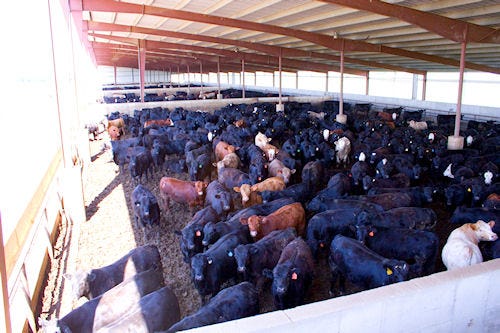January 20, 2012

Bed pack barns are all the rage, and for good reason. Comparisons conducted at the South Dakota State University's Opportunities Farm near Lennox show cattle finished in a monoslope barn with a bed pack gain faster and more efficiently than in open lots. The difference in performance is greatest (about 10%) from January through March.
But winter poses some air flow challenges, says Ben Holland, SDSU Extension beef feedlot specialist.

Airflow in monoslope bed pack barns is critical in winter. Side curtains should be open except in the worst weather.
"Cattle are exceptionally cold-hearty and their winter hair coats provide excellent insulation when cattle are dry. This is evident when cattle are seen with snow on their backs in the winter. Cattle with heavy winter hair coast would not be expected to utilize excess energy to stay warm until temperatures fall below 17 ºF, unless they are exposed to severe wind or the coat loses insular ability due to moisture or caked mud," he says.
In feeding barns, stem walls are usually 4 to 5 feet tall, which is as tall as cattle. When cattle are stocked in a barn at 35 to 45 square feet per head, air movement down in the pen can be severely restricted. When this occurs, air quality may decrease because of ammonia generated by the manure and bed-pack, Holland says.
"Adjustable curtains should primarily be left open except in the most extreme conditions, such as temperatures below zero with wind, rain or snow, or [in] blizzard conditions," he says.
When planning and designing a barn, Holland says to keep the following airflow requirements in mind:
Monoslope barns generally should be no wider than 100 feet, as wider barns may have less affective air movement.
The opening between the top of the stem wall and the roof should provide about 1 vertical foot for every 10 feet of barn width.
When locating barns relative to windbreaks, other buildings or shelter belts, maintain a distance of at least five times the height of the obstruction
Consider installing automatic curtain operators to optimize the environment in the barn.
"Cattle feeding barns, and the cattle in them, are large investments, and facility design and management should be well thought out and fine-tuned to provide the greatest return. Sometimes when our best intentions work a little too well, animal performance can be compromised," Holland says.
Source: SDSU
You May Also Like




